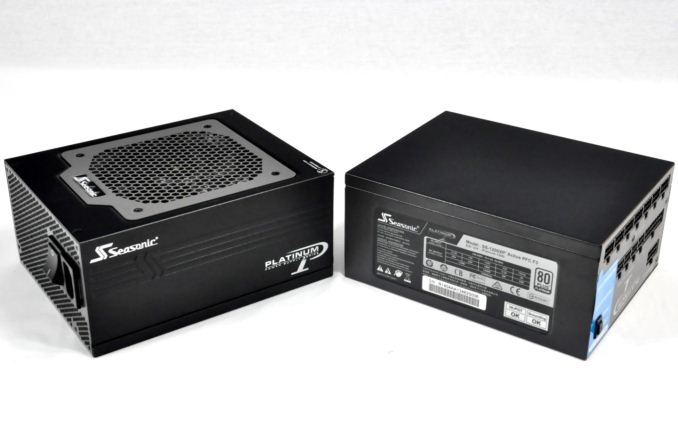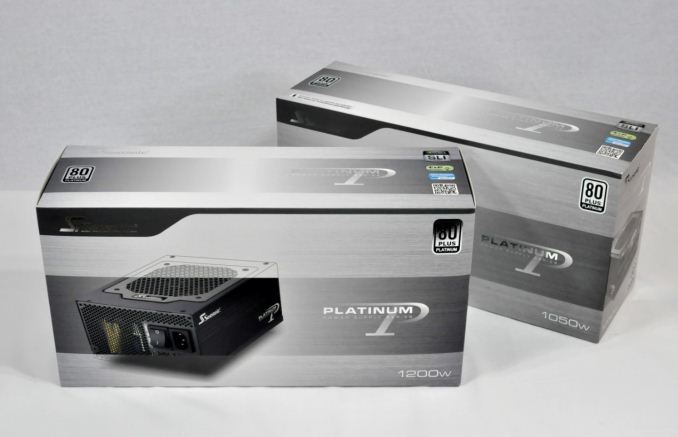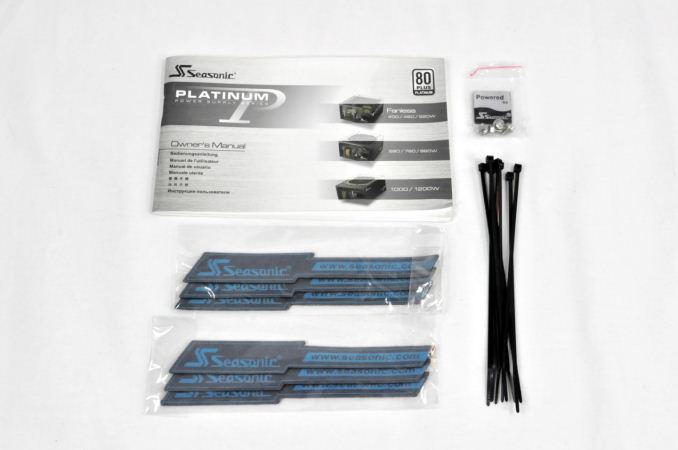Seasonic Platinum SS-1050XP3 & SS-1200XP3 Power Supply Review
by E. Fylladitakis on September 3, 2014 6:00 PM EST- Posted in
- Cases/Cooling/PSUs
- Seasonic
- 1200W
- 80Plus Platinum
- 1050W

Introduction
The 80 Plus program was introduced a decade ago with the aim of promoting the development of more efficient and environmentally friendly computer PSUs. Since then, it has undoubtedly become one of the favorite subjects of PSU marketing teams. Not long ago, an 80 Plus Bronze certification was more than adequate for a mainstream product, with 80 Plus Gold certifications reserved for premium product ranges. Today, 80 Plus Gold certified units can be found retailing at very reasonable prices, slowly but surely making the 80 Plus Bronze certification fit only for low-range products.
There also are numerous 80 Plus Platinum certified products available and even a few 80 Plus Titanium certified units, such as the Corsair AX1500i, are making their appearance, albeit their ludicrous price tags. Meanwhile, the pricing of 80 Plus Platinum certified PSUs has become more reasonable, allowing the manufacturers to effectively implement the technology in their medium and high-end units. Today we have a couple more 80 Plus Platinum PSUs on our test bench.
Seasonic is a very well-known manufacturer of high quality PSUs, so they hardly need an introduction. Today, we are going to look at two of the new additions to their Platinum series, the Platinum SS-1050XP3 1050W and the Platinum SS-1200XP3 1200W. The name of the series is obviously linked with the 80 Plus Platinum efficiency certification of the units and it is their top-tier series, so these two new models also are the best consumer-grade PSUs that Seasonic currently offers. The 1050W and 1200W versions currently retail for $230 and $250 respectively, which are fairly reasonable prices considering their class and power output. How well can they perform though? We will find out in this review.
| Platinum SS-1050XP3 - Power specifications ( Rated @ 50 °C ) | |||||
| AC INPUT | 100 - 240 VAC, 50 - 60 Hz | ||||
| RAIL | +3.3V | +5V | +12V | +5Vsb | -12V |
| MAX OUTPUT | 25A | 25A | 87A | 3A | 0.5A |
| 125W | 1044W | 15W | 6W | ||
| TOTAL | 1050W | ||||
| Platinum SS-1200XP3 - Power specifications ( Rated @ 50 °C ) | |||||
| AC INPUT | 100 - 240 VAC, 50 - 60 Hz | ||||
| RAIL | +3.3V | +5V | +12V | +5Vsb | -12V |
| MAX OUTPUT | 25A | 25A | 100A | 3A | 0.5A |
| 125W | 1200W | 15W | 6W | ||
| TOTAL | 1200W | ||||
Packaging and bundle
We received both units in a long, very well designed cardboard box, with an elegant brushed metal color theme and reflective lettering. Inside the thick cardboard walls of the box, the unit is protected by Polyethylene foam pieces and is wrapped inside a synthetic cloth pouch, which can be repurposed. Information on the performance and the features of the unit can be found on the back of the box.
Both units share the same bundle, consisting of a well written manual, a case badge, four typical 3M mounting screws, a few cable ties, and six cable straps. We imagine that many enthusiasts would prefer black screws instead, but that is a minor misstep.
Both units share almost the same set of cables as well, with the exception that the 1200W version offers ten 6+2 pin PCI-E connectors instead of eight. The cables come supplied in a dual compartment nylon bag with the series logo printed on both sides. With the exception of the 24-pin ATX cable, all of the cables are flat, ribbon-like cables with no sleeving. The 24-pin ATX cables uses black wires as well, but they are individual wires and are covered with black sleeving.














39 Comments
View All Comments
ijozic - Thursday, September 4, 2014 - link
It sounds like it would cost noticeably more for something most people PROBABLY won't really care about. And the market is already quite competitive..Samus - Thursday, September 4, 2014 - link
The only complicated factor is space inside the standard ATX housing, but considering there are 500-watt 80+ Gold SFX PSU's that are 1/3rd the size of ATX, making a 100-watt primary stage with a 1000-watt secondary stage shouldn't be impossible. The most expensive part would likely be the cap for the relay (1/4 farad) and obviously that cap is going to be pretty large, most electrolytic caps this size are around 5" long.I think the BOM would be ~$20, and engineering it in isn't rocket science. This could totally be done, and if I were paying $200+ for a PSU, I'd expect some level of engineering beyond a good bridge design and PFC.
jann5s - Thursday, September 4, 2014 - link
have a look at the pico-PSU, these go up to 160W and are approximately the size of the ATX-plug attached to the umbilical coard of your PSU, this will definately fit.DanNeely - Thursday, September 4, 2014 - link
With a picoPSU you need to look at not just the 12V to 3.3/5V (smaller models) or 19V to 12/5/3.3V circuitry on the ATX plug; but the size of the external power brick used to feed it. It's still probably feasible volumetrically, but isn't nearly as much of a gimmie as just looking at the size of the ATX plug module implies.DanNeely - Thursday, September 4, 2014 - link
... especially since this could potentially be done by beefing up the existing Vsb circuit instead of adding something entirely new. JonnyGuru's testing shows current Vsb implementations aren't particularly impressive at only around 80%; but depending on how much worse current models perform below 10% some gains might still be reasonable. With the Titanium spec mandating 90% efficiency at 10% load though I'm not sure it's really worth it. On the 300-700W units that are suitable for ~90% of enthusiast systems 10% of rated power is generally enough to cover idle loads as long as you don't do anything silly (eg running an IGP powered low power mITX board with an SLI capable PSU). OTOH idle loads are steadily improving with each new CPU/GPU generation and the 80+ group will need to extend the standard to be tougher somewhere for whatever comes after titanium.TelstarTOS - Thursday, September 4, 2014 - link
I totally agree. What's holding me to get a 1000W+ PSU is the efficiency at low loads. With CPUs getting more and more green, PSUs should do the same and not only when under full load (which is a countersense if you really think about it).DanNeely - Thursday, September 4, 2014 - link
More attention is being paid to lower end efficiency than in the past; and this PSU is a prime example. While it falls short of the (new) 90% efficient at 10% load requirement for 80+ titantium, it's ~89% efficiency is much better than any of the other PSUs reviewed earlier this year did; none of which did better than the low to mid 80's at that level.Phillip Wager - Monday, September 8, 2014 - link
i like the dual stage idea but i am assuming most consumers are not willing to pay more for additional cost/complexity because that small amount of power that you are wasting turns out to be a very small amount of money over the lifetime of the system. I am somewhat suprised with your test results with your system because my computer has nearly identical specs and i have a 600 watt power supply and i have never had so much as a hiccup. Maybe get a different device for measuring power draw or perhaps your power supply is not as inefficient as you think.bsim500 - Thursday, September 4, 2014 - link
I agree, but there's not much you can do. It's the nature of high-wattage PSU's. If they came out with a 95% efficient "super platinum" PSU, lower wattage PSU's would adopt the same technology and the "idle gap" would still remain.Personally, I have a Seasonic G360 (yes, 360W PSU) that perfectly feeds an i5 + 7870 GFX card, and pulls (measured at the wall) : 182w peak Prime + Furmark / 110-150w typical gaming load / 88w 4T Prime or X264 encode load (CPU only) and 37w idle (which falls to 26w if discrete GFX card is removed, and that's with 1600MHz Ivy Bridge idle, not 800MHz Haswell), never pulling more than 50% PSU draw even under combined synthetic CPU+GPU "power viruses", and spending 90% of its time at +90% PSU efficiency with a virtually silent fan.
That 26-37w idle wattage on these PSU's is barely 50-60% efficiency level, yet the number of people who "swear" they "need" a 1200w PSU just for a single mid-range dGPU gaming rig is quite comical. ;-)
Samus - Thursday, September 4, 2014 - link
I know, "right sizing' a PSU is something few people understand. The worst thing you could do to your wallet is spend a fortune on a 600+ watt PSU and spend another fortune paying for it to inefficiently idle over the years for that i5 with integrated graphics and a single hard disk...